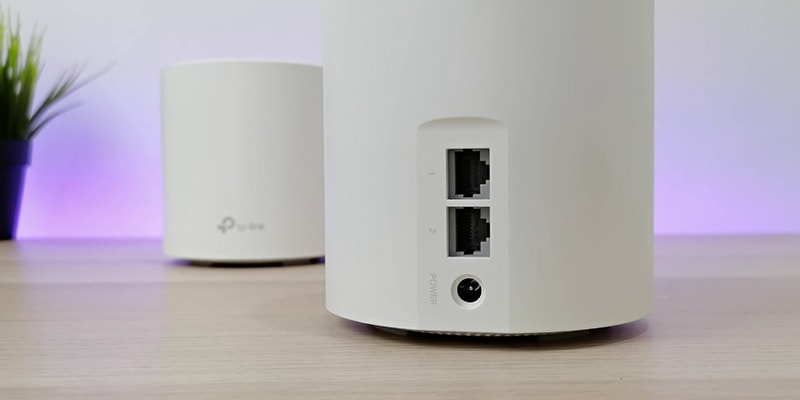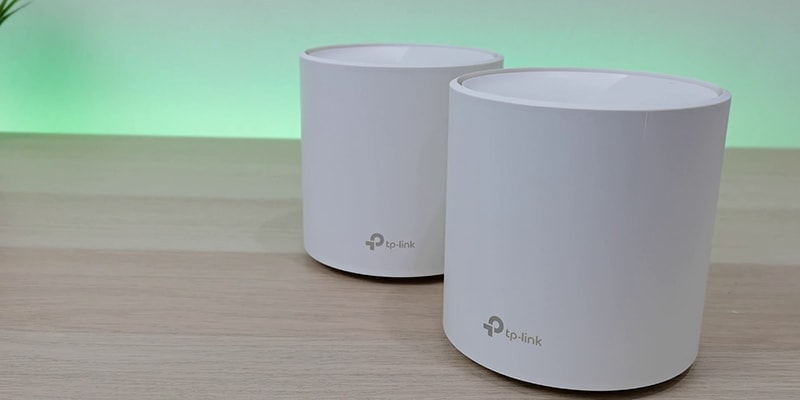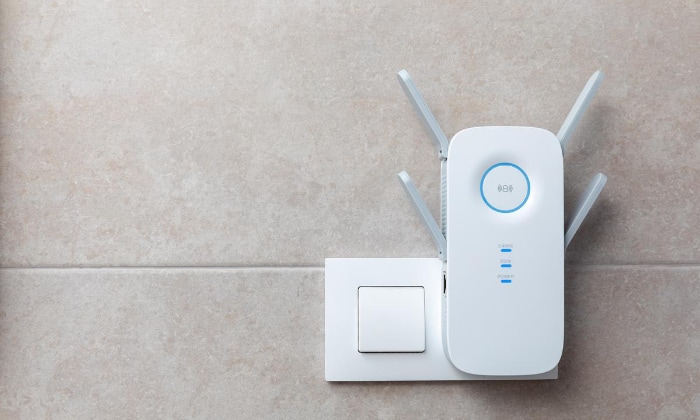Wi-Fi Mesh Network vs. Range Extender: Which to Pick?

Frustrating Wi-Fi dead zones that cause dropped video calls and endless buffering often prompt a search for a better solution. The two most common approaches to fix inconsistent coverage are Wi-Fi range extenders and mesh network systems.
A range extender works by capturing and rebroadcasting your router’s existing signal to extend its reach into a specific problem area. A mesh system, however, replaces your current setup with multiple nodes that work together to create a single, seamless network across your entire home.
Deciding between them depends on the size and complexity of your space, your need for smooth roaming from room to room, and the trade-offs you are willing to make between performance and budget.
How They Work
While both Wi-Fi extenders and mesh systems aim to eliminate poor signal areas, they achieve this goal through fundamentally different methods. A mesh system is built on the principle of cooperative nodes creating a single, cohesive network.
In contrast, a range extender operates as a simple repeater, capturing your router's signal and rebroadcasting it to expand its reach.
Mesh Architecture
A mesh Wi-Fi system uses multiple nodes or satellite units placed throughout a home or office to create a wide blanket of coverage. These nodes communicate with each other, forming a single, unified network that shares the same name and password, known as the SSID.
As you move around the space with a device like a phone or laptop, the system intelligently and automatically hands off your connection to the node providing the strongest signal. This process is seamless, ensuring a stable connection without any interruption to your activity.
Extender Operation
A range extender is a single device that wirelessly connects to your existing router, captures its signal, and then rebroadcasts it. This process effectively extends the Wi-Fi signal into a previously unreached area, such as a distant room or a different floor.
In most cases, the extender creates a new network with a name that is slightly different from your main network, often with “_EXT” added to the end. The purpose is to provide a signal boost to a specific, targeted dead zone.
Network Behavior
The practical experience of using these two solutions differs significantly. With a mesh network, your devices see only one network, allowing for automatic and uninterrupted roaming throughout the entire coverage area.
You can walk from one end of the house to the other during a video call without experiencing a drop. An extender, however, creates a separate network.
To get the best connection, you often need to manually switch your device’s Wi-Fi from your main router to the extender’s network as you move closer to it, a process that can disrupt active downloads, streams, or calls.
Coverage and Roaming

The effectiveness of a Wi-Fi solution is defined by how well it covers your space and how it handles your devices as you move. Mesh systems and range extenders provide coverage in fundamentally different ways, which directly affects the experience of using Wi-Fi while moving around your home.
The layout of a property and where you place the hardware are also critical factors in determining the final performance.
Coverage Ranges
A single range extender is designed to provide a targeted boost, typically adding between 300 and 2,000 square feet of coverage to an existing network. This makes it a suitable fix for a specific dead zone, like a back patio or an upstairs bedroom.
In contrast, mesh Wi-Fi kits are built for whole-home coverage from the start, with typical two or three-piece systems blanketing areas from 2,000 to over 5,500 square feet. Furthermore, mesh systems are inherently scalable; you can purchase additional nodes to seamlessly expand the network into a larger home, basement, or garage.
The Roaming Experience
A mesh network provides a truly seamless roaming experience because all nodes operate under a single network name. As you walk through your home, your phone or laptop automatically connects to the node offering the strongest signal without any interruption.
This allows for uninterrupted video calls or media streaming as you move between rooms. An extender, however, commonly creates a separate network that requires manual switching.
Your device will often cling to the router's weak signal even when you are closer to the extender, forcing you to go into your settings and change networks to get a better connection.
Placement and Strategy
Proper placement is critical for both solutions, but the strategy differs. An extender must be placed in a “sweet spot” midway between your router and the dead zone.
If it is too close to the router, its extended range will not reach the intended area; if it is too far, it will receive a weak signal that it can only rebroadcast at a reduced speed. Mesh nodes are designed to be distributed throughout the home.
The primary node connects to your modem, and the satellite nodes are placed in various rooms to ensure they maintain strong communication links with each other, creating a robust and overlapping web of coverage.
Performance and Reliability
Beyond just covering a physical area, the quality of a Wi-Fi signal is measured by its speed and stability. The architectural differences between mesh systems and range extenders lead to significant variations in performance consistency and how they handle real-world obstacles.
A solution that provides reliable throughput across an entire home is often more valuable than one that simply extends a weak signal.
Throughput Consistency
Mesh systems are engineered to deliver consistent performance throughout the entire coverage area. Because the nodes intelligently communicate with one another, they can route data efficiently, often using a dedicated wireless channel, or backhaul, to maintain high speeds between nodes.
This optimization results in a network that sustains more of its potential speed, even when you are connected to a satellite node far from the main router. The overall performance feels more uniform and dependable from room to room.
Extender Trade-Offs
A range extender inherently involves performance compromises. Most basic extenders operate on a single wireless band to both receive the signal from the router and transmit it to your devices.
This process can effectively cut the available bandwidth in half, leading to a noticeable drop in speed. Repeating the signal also introduces additional latency, which can cause lag in online gaming and buffering during video calls.
The performance degradation becomes more severe the farther the extender is from the main router, as it is rebroadcasting an already weakened signal.
The Physical Environment
A home's construction materials and layout significantly impact Wi-Fi performance. Walls, floors, large furniture, and appliances can block or degrade signals.
A single range extender may struggle to push a usable signal through multiple obstacles, resulting in an unreliable fix for a dead zone. Mesh systems are generally more resilient in these environments.
With multiple nodes spread throughout the house, the system can find clearer paths for the signal to travel around obstructions, maintaining a more stable and even connection in homes with complex or challenging layouts.
Setup and Management

The initial installation and long-term administration of your network are important considerations that differ greatly between the two solutions. Mesh systems are designed for streamlined, user-friendly control over the entire network from a single point.
In contrast, range extenders are treated as individual devices, each requiring its own setup and separate management.
The Setup Process
Setting up a range extender is typically a straightforward, one-device task. It usually involves plugging the extender into a power outlet, connecting to it from a computer or phone, and following a web-based configuration wizard to link it to your main router's network.
While simple for a single unit, adding multiple extenders means repeating this process for each one. Mesh systems offer a more holistic and guided setup experience.
After connecting the primary node to your modem, a dedicated smartphone app walks you through placing the satellite nodes and creating your new network, often deploying the entire system in just a few minutes.
Ongoing Control and Management
A major advantage of a mesh system is its centralized management. Through a single app, you can monitor all connected devices, check the status of each node, run speed tests, and update the system's firmware with a single tap.
Many also offer advanced features like parental controls and guest networks that apply across the entire home. Managing an extender is a more isolated affair.
To make changes or update firmware, you typically need to log into that specific extender's administrative interface. If you have more than one, you must manage each device separately, which can become cumbersome.
The Role of Your Router
Range extenders are designed exclusively as add-ons to an existing Wi-Fi router; they cannot function on their own. They depend on your current router to create the network that they then repeat.
Most mesh systems, however, are intended to be a complete replacement for your current router. The main mesh node serves as the new router for your home, connecting directly to your internet modem.
While some mesh systems can be configured to work in conjunction with an existing router in “access point” or “bridge” mode, their primary design is to create a new, superior network from scratch.
Cost and Scalability
The financial outlay and the potential for future expansion are practical factors that heavily influence the choice between a Wi-Fi extender and a mesh system. An extender provides a low-cost entry point for solving a small problem, whereas a mesh system requires a larger initial investment but offers a much more elegant and effective path for growth.
Comparing the Costs
There is a significant price difference between the two solutions. A good quality range extender is an affordable purchase, typically costing between $50 and $80, making it an accessible option for a quick fix.
In contrast, mesh Wi-Fi systems are sold as multi-unit kits and represent a more substantial investment, with prices for starter packs generally ranging from $200 to more than $500. Expanding a mesh network also carries an ongoing cost, as individual add-on nodes usually cost between $100 and $200 each.
Options for Growth
The way each system scales to cover a larger area is a defining difference. To expand a mesh network, you simply add another node, which seamlessly integrates into the existing system under the same network name.
The process is designed to be simple and preserves the unified network experience. Expanding coverage with extenders is less graceful.
Adding a second or third extender means you will likely have to configure each one individually, and each will create its own separate network, leading to a confusing web of different SSIDs to choose from as you move around.
Finding the Right Value
The best value depends entirely on the specific problem you need to solve. For a smaller apartment or a house with only one or two distinct dead zones, a single, budget-friendly range extender provides an effective and economical solution.
However, for large or multi-story homes, or those with complex layouts and many connected devices, the higher price of a mesh system is justified. Its ability to deliver consistent speed, seamless roaming, and simple scalability provides superior long-term value in a demanding environment.
Conclusion
Choosing the right solution depends on your specific goals for your home network. A mesh Wi-Fi system is the recommended choice for larger or multi-story spaces, households with numerous connected devices, and for users who rely on seamless roaming for activities like video calls.
If your priority is maintaining consistent, high-speed performance across every room, the investment in a mesh network will deliver a far superior experience. Conversely, a range extender serves as an excellent, budget-friendly option for targeted fixes.
If you simply need to eliminate a dead zone in a single room or a small area and are willing to accept the presence of a separate network and a potential reduction in speed, an extender is a practical and effective solution.


